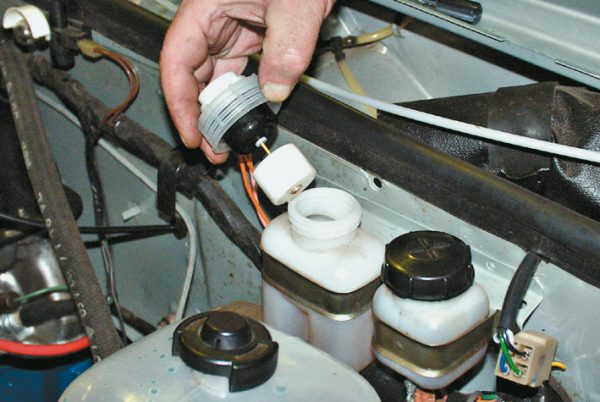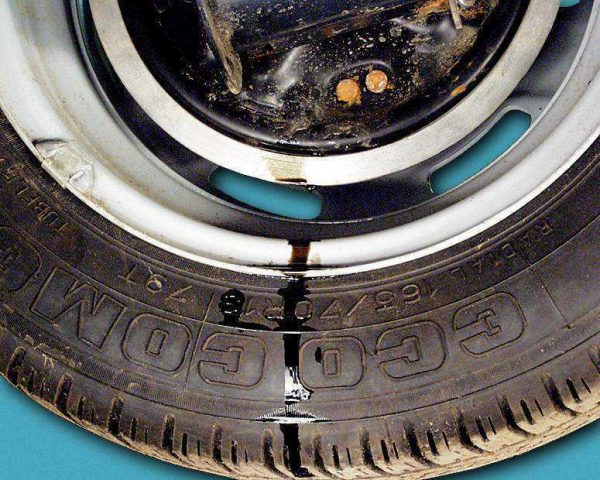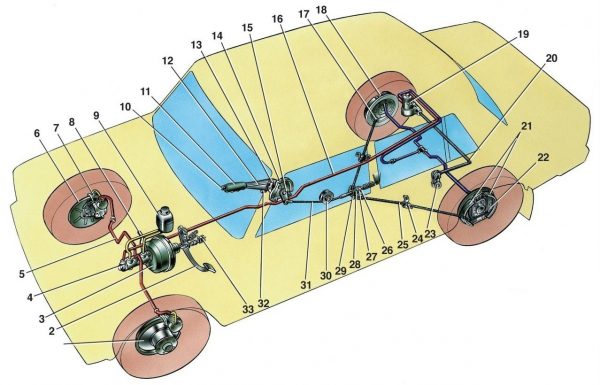
Malfunctions and bleeding of the brake system VAZ 2107
Content
VAZ 2107 - the car is far from perfect, it cannot boast of the reliability of its systems. Including brake mechanisms, on which the safety of driving depends. Sometimes there are situations when the system is not working efficiently or there is a leak of brake fluid - in such cases, urgent repair is required. You can do the work yourself, for which you will need to prepare the necessary tools and read the instructions.
Malfunctions of the brake system VAZ 2107
The safety of driving the VAZ 2107, like any other car, directly depends on the effectiveness of the braking system. If problems occur with it or repair is carried out, pumping the brakes is required. In order for the system to always be in good condition, you need to know how malfunctions manifest themselves and what causes them.

Soft brake pedal
The normal state of the brake pedal on the "seven" is one in which at the moment it is pressed there are no jerks or dips and no special efforts are required. However, as the vehicle is used, drivers may encounter a situation where the brake pedal has a different state: it may be too soft or hard. Both phenomena are considered unacceptable and indicate a malfunction in the braking system and the need for an early repair. Most often, the pedal becomes soft when the system is aired. Sometimes this phenomenon is also called a failure. The malfunction is eliminated by bleeding the brakes, as a result of which air is removed from the system, which could enter it for the following reasons:
- Too little brake fluid in expansion tank.
- Violation of the tightness of the braking system.
- Malfunction in the main brake cylinder (GTZ). The problem is fixed by repairing the mechanism.
 The brake fluid level is checked in the expansion tank, which is located next to the clutch fluid reservoir.
The brake fluid level is checked in the expansion tank, which is located next to the clutch fluid reservoir.
Hard pedal
Excessive force to press the brake pedal is mainly required when the vacuum booster (VU) is faulty. This device creates a vacuum in the intake manifold, due to which the necessary braking torque arises with little effort from the driver.
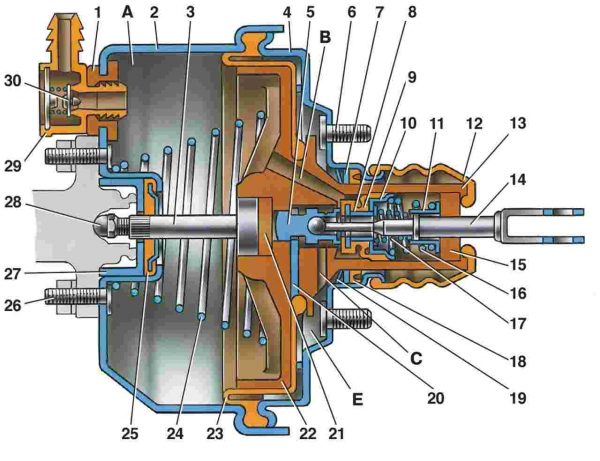
The reasons that lead to the fact that the pedal becomes tight may be the following:
- The air filter of the vacuum booster (VU) is clogged. Eliminate by replacing the filter.
- The valve body is jammed in the VU. To solve the problem, the vacuum booster is replaced.
- The vacuum booster diaphragm is damaged. The malfunction is eliminated by replacing the VU.
- The tip of the vacuum booster is out of order. The tip itself needs to be replaced.
- The non-return valve in the VU does not work correctly. To fix the problem, they change it.
- Violation of tightness. The vacuum booster or non-return valve needs to be replaced.
- Failure of the hose connecting the VU and the intake manifold, or the clamp on it is loosely tightened. The problem is eliminated by replacing the hose or tightening the clamp. The state of the hose must be monitored regularly.. Over time, the rubber can delaminate, which leads to a decrease in the amount of fluid passing through it..
- An increase in the size of the cuffs in the working brake cylinders, which often occurs due to the use of poor quality brake fluid. 6533853: 24.05.2018/16/37 XNUMX:XNUMX PM
It's not entirely clear what's wrong here. Please leave meaningful comments that indicate at least approximately what is wrong.
“> The malfunction is eliminated by replacing the rubber seals and the fluid itself. The vacuum booster is connected to the intake manifold with a hose, which is often the cause of poor braking due to loss of tightness or loose clamp tightening
The vacuum booster is connected to the intake manifold with a hose, which is often the cause of poor braking due to loss of tightness or loose clamp tightening
One wheel does not brake
Sometimes there are situations when one of the wheels slows down worse than the others, or there is no braking at all. Causes may be brake pads or cylinders, assuming the system is bled and there are no leaks. To determine in more detail what caused the problem, you will need to unscrew the wheel and inspect the brake drum and pads. Then you should ask someone to press the brake pedal. The force should be small, but sufficient to push the pistons slightly out of the cylinders. If this does not happen, then the node needs to be replaced. In addition, you need to try to return the pistons back to the cylinders by "pressing" them with a screwdriver. If this fails, then the mechanism must also be replaced. The pistons of the front brake cylinders can "sour" due to the rupture of the rubber boot, as a result of which they become immobile.
The procedure for checking the rear and front brakes is the same.
Fluid is leaking from the tank
One of the maintenance items for the VAZ 2107 is to control the level of brake fluid in the expansion tank. If it was found that it has decreased, it is imperative to find out the reason that led to this. It is not worth tightening, since breakdowns are possible in the braking system, which can lead to failure at the moment of emergency pressing the brake pedal. Consider the most likely reasons why fluid can leave the tank:
- Leak through the brake cylinder. It is necessary to inspect the working mechanisms of braking for smudges. To do this, you need to get under the car, for example, on a flyover, and pay attention to the inside of the wheels. If traces of fluid are found, the defective cylinder must be repaired or replaced.
- Depressurization of the braking system as a result of wear of the cuffs of the main brake cylinder. It is not difficult to determine this kind of malfunction. To do this, check the GTZ for smudges. If traces of brake fluid are found, it will be necessary to repair or replace the product with a new one.
- When inspecting the elements of the braking system in order to detect fluid leaks, do not lose sight of the rubber hoses. Over the years, the rubber dries up and cracks form on the surface of the products, through which the liquid seeps through. If traces of leakage were found at the junction of hoses to cylinders or tubes, as well as on the surface of rubber elements, they must be replaced.
 Leakage of brake fluid can occur, for example, through the working brake cylinders
Leakage of brake fluid can occur, for example, through the working brake cylinders
As the brake pads wear out, the piston stroke in the working brake assembly increases, which can also lead to a decrease in the fluid level in the reservoir.
In any case, it is necessary to control the level and prevent it from dropping below the minimum mark, timely topping up the liquid.
Repair of the main and working brake cylinders
The main brake cylinder is the main part of the hydraulic brake drive. When the driver presses the brake pedal, the GTZ creates high pressure in the system, which sets the pistons of the braking mechanisms in motion. The latter press the brake pads against the discs and drums.
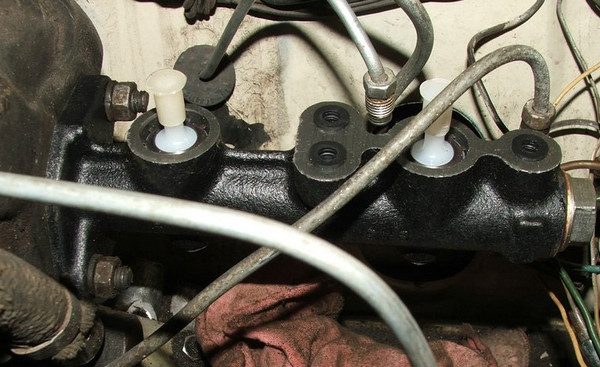
Repair or replacement of the master cylinder is carried out in the event that the unit does not cope with its functions. To carry out repair work, the mechanism must be dismantled from the car and disassembled. This will require a set of keys and screwdrivers, as well as a repair kit for the GTZ and brake fluid. To dismantle the cylinder, you need to remove the hoses and tubes connected to it, and then unscrew the fasteners to the vacuum booster. To disassemble, carefully unscrew the plug nut so that the parts located inside do not scatter to the sides. After disassembly, the worn elements are replaced with parts from the repair kit. Assembly is carried out in reverse order.
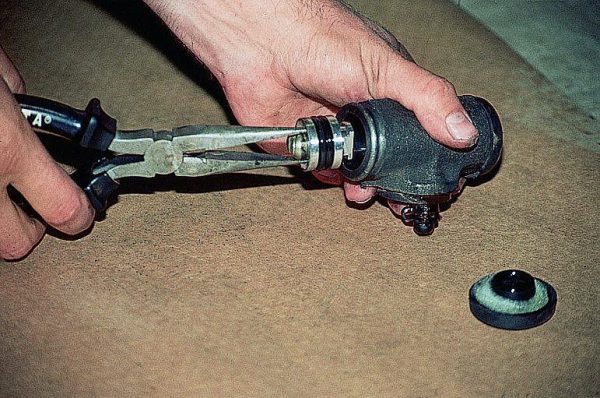
Work brake cylinders are repaired in the same way. If the cuffs or piston are in poor condition, then the parts need to be replaced. It is best to change the entire cylinder, which will be much more reliable.
Video: GTC overhaul of VAZ 2107
Replacing the brake hoses
Brake hoses are changed when smudges are detected, which appear as a result of aging rubber. The technical literature says that hoses that were installed on a car more than three years ago are highly undesirable to operate. This is explained by the fact that rubber not only ages, but also undergoes more deformation.
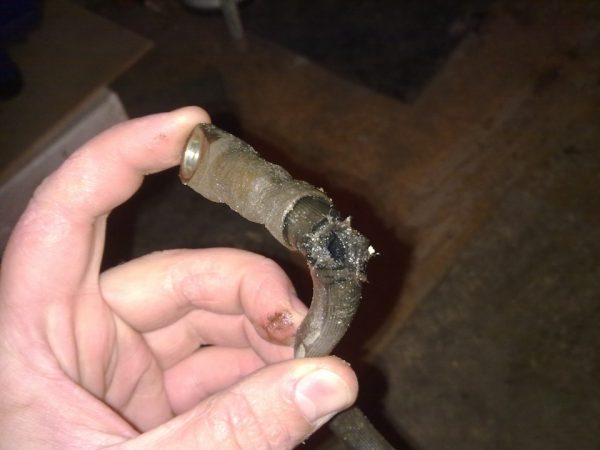

Brake hoses on the VAZ 2107 are located both in the front and in the rear of the car. They bring brake fluid to the working cylinders. Having decided that the rubber element needs to be replaced, you need to prepare the following list of tools and materials:
- pliers;
- screwdriver;
- a set of keys;
- new hose;
- brake fluid.
The brake hose is replaced as follows:
- The front wheel is removed from the corresponding side so that you can get to the caliper.
- On the reverse side, the bolt that secures the hose is unscrewed and removed along with the copper washers.
- Unscrew the hose at the point of its attachment to the brake pipe.

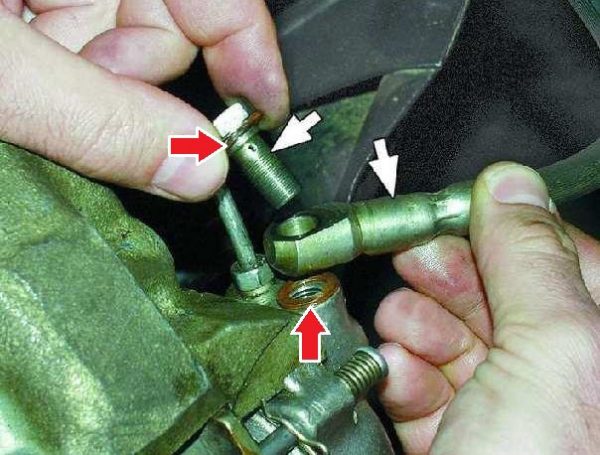 The brake hose is attached to the working cylinders with a bolt and copper washers.
The brake hose is attached to the working cylinders with a bolt and copper washers.
The washers are replaced with new ones during the repair process, since they are used as seals, and when installing old parts, there is a possibility of leakage of brake fluid.
The rear brake hose is attached in the same way, with the only difference that the front one is attached to the caliper with a bolt, and the rear one with a nut. To disconnect the hose and the tube, you need to use the keys: one unscrew the tube, the second hold the nut of the flexible element. After the tube is slightly loosened, the stopper is removed with pliers. Having completed the dismantling of the damaged part, they install a new one. At the end of the procedure, the tank is filled with brake fluid, after which the system is pumped.
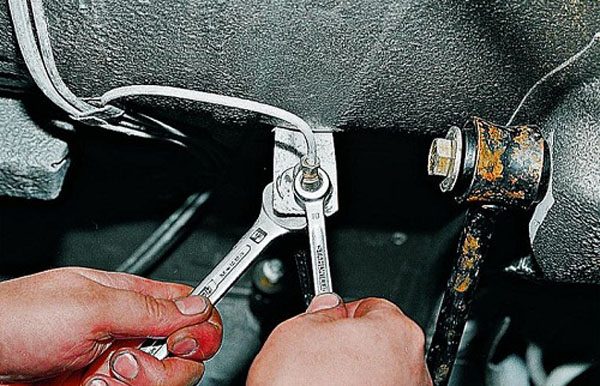

Vibrations in steering wheel and brake pedal
Although rare, there are still situations when, at the moment you press the brake pedal, vibration is felt, and not only the pedals, but also the steering wheel. The reason for this is a warped brake disc. The appearance of a breakdown is possible with aggressive driving, when you need to brake often and sharply. At the same time, the disks heat up, and if water gets on them at this moment, a temperature difference occurs, which contributes to the destruction of the disk. Due to such damage, loss of control of the car and other unpleasant consequences are possible. When this malfunction occurs, it is imperative to visit the service station, where the damaged brake disc is subjected to a groove.
What brake fluid to fill in the VAZ 2107 and how much
The VAZ 2107 hydraulic brake system uses DOT-4 brake fluid. Its volume is 0,382 liters. The liquid is added or changed not only in case of repair, but also when the color changes or moisture gets into it. As a rule, on the classic Zhiguli, a complete fluid change is performed every 3 years. The essence of the procedure is to pump fluid through the system.


How to bleed the brakes
To pump the brakes on the "seven", as a rule, 2 people are required: one is under the car and works directly with the brake cylinders, and the second is located in the passenger compartment and presses the brake pedal. The following tools are required for work:
- box wrench 8/10;
- wrench 8/10 open-end or special for brake pipes;
- hose of the appropriate diameter;
- container for waste liquid.
Pumping starts from the farthest wheel from the GTZ, so it is performed in the following sequence:
- Right rear wheel.
- Left rear.
- Right front.
- Left front.

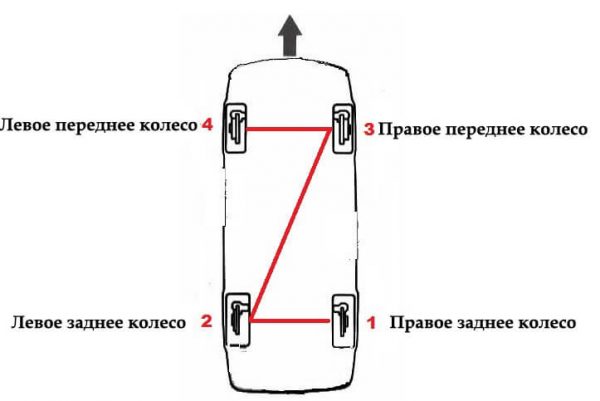 Brakes must be bled in a certain sequence
Brakes must be bled in a certain sequence
To bleed the brake mechanisms of the rear wheels, you need to go down under the car. Work with the front brakes is carried out after the preliminary dismantling of the wheels. The rest of the process is the same:
- Remove the protective cap from the fitting of the working brake cylinder.

 A rubber cap is used to protect the fitting from contamination.
A rubber cap is used to protect the fitting from contamination. - Put an 8/10 ring wrench on the fitting and slightly loosen the tightening.

 The tightening of the fitting is loosened with a spanner wrench by 8/10
The tightening of the fitting is loosened with a spanner wrench by 8/10 - A hose is connected to the fitting, the other end of which is lowered into the container.
- Press the brake pedal until it becomes hard and hold it down.

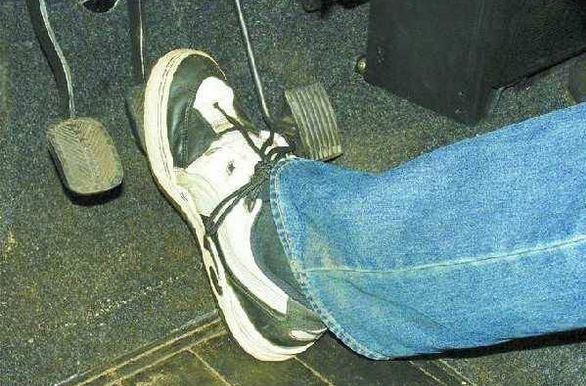 The brake pedal is pressed several times until it becomes hard
The brake pedal is pressed several times until it becomes hard - Unscrew the fitting half a turn, while the brake fluid begins to flow through the hose, and the pedal rests on the floor. Until the fluid stops flowing, do not release the pedal.

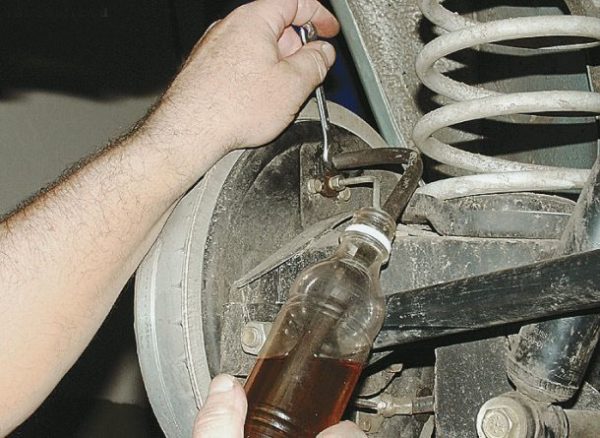 The fitting is turned half a turn so that liquid begins to flow out of the hose
The fitting is turned half a turn so that liquid begins to flow out of the hose - Wrap the fitting and repeat the procedure until liquid begins to flow through the tube without air bubbles.
- The procedure is repeated with other wheels of the car.

 Remove the wheel to bleed the front brake.
Remove the wheel to bleed the front brake. - At the end of pumping, the fitting is closed with a rubber cap.
During pumping, you need to control the fluid level in the expansion tank so that no air enters the system.
Video: pumping brakes on a VAZ


Watch this video on YouTube
Why are the brakes not pumping?
One of the problems that many owners of the VAZ 2107 face is the impossibility of bleeding the brakes after repairing or replacing the master brake cylinder. It would seem that a new or repaired part is installed, pumping is performed correctly, but the result is zero. The essence of the problem lies in the fact that in most cases, when installing the GTZ, pipes and hoses are first connected to it, then the brake fluid is poured into the reservoir, and only after that they start pumping. However, there is air in the cylinder itself, so you first need to bleed it, and then proceed to the brakes.
The fact that there is air in the GTZ is also evidenced by the brake pedal, which lies on the floor.
To deal with the problem, you do not need to tighten the fittings on the tubes - just tighten them. After that, brake fluid is poured into the reservoir and the fittings are released a few turns so that fluid with air comes out of them. Alternatively, to speed up the process, you can wipe the neck on the tank and blow into it to create pressure. After the liquid goes without air, the fittings are clamped and proceed to the standard procedure for bleeding the brakes.
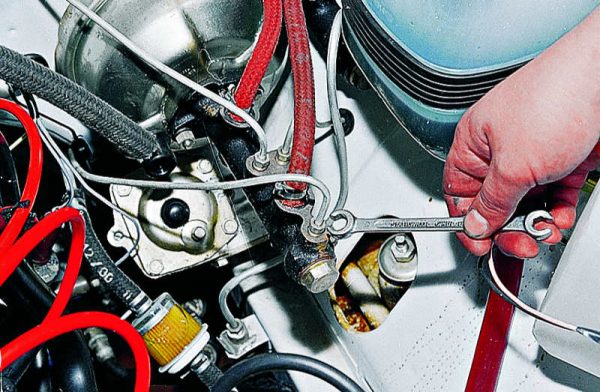

In addition, a bleeding problem may occur when a defective cylinder is installed or when the part is incorrectly repaired. If a problematic product comes across, the liquid is bypassed, which simply flows from the tank to the cylinder and back, i.e., it does not pass beyond the GTZ. In this case, the part must be replaced. If the cylinder has been repaired, it will be necessary to repeat the procedure, since, most likely, an error was made during assembly.
In order for the GXNUMX brake system to work properly, it is necessary to periodically inspect its elements, control the level of brake fluid in the expansion tank, and if it decreases, identify the cause that led to this. Since many problems with the hydraulic brake system require bleeding, you need to know what to do and in what sequence - there is nothing difficult in this process.


